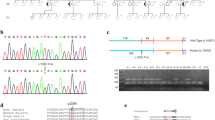Abstract
Variations in the mitochondrial helicase Twinkle (PEO1) gene are usually associated with autosomal dominant chronic progressive external ophthalmoplegia (PEO). We describe five patients from two unrelated Alsatian families with the new R374W variation in the Twinkle linker region who progressively developed an autosomal dominant multisystem disorder with PEO, hearing loss, myopathy, dysphagia, dysphonia, sensory neuropathy, and late-onset dementia resembling Alzheimer’s disease. These observations demonstrate that Twinkle variations in the linker domain alter cerebral function and further implicate disrupted mitochondrial DNA integrity in the pathogenesis of dementia.

Similar content being viewed by others
References
Spelbrink JN, Li FY, Tiranti V et al (2001) Human mitochondrial DNA deletions associated with mutations in the gene encoding Twinkle, a phage T7 gene 4-like protein localized in mitochondria. Nat Genet 28:223–231
Virgilio R, Ronchi D, Hadjigeorgiou GM et al (2008) Novel Twinkle (PEO1) gene mutations in mendelian progressive external ophthalmoplegia. J Neurol 255:1384–1391
Jeppesen TD, Schwartz M, Colding-Jorgensen E, Krag T, Hauerslev S, Vissing J (2008) Phenotype and clinical course in a family with a new de novo Twinkle gene mutation. Neuromuscul Disord 18:306–309
Baloh RH, Salavaggione E, Milbrandt J, Pestronk A (2007) Familial parkinsonism and ophthalmoplegia from a mutation in the mitochondrial DNA helicase Twinkle. Arch Neurol 64:998–1000
de Camaret Mousson B, Taanman J-W, Padet S et al (2007) Kinetic properties of mutant deoxyguanosine kinase in a case of reversible hepatic mtDNA depletion. Biochem J 402:377–385
Ferlin T, Guironnet G, Barnoux MC, Dumoulin R, Stepien G, Mousson B (1997) Detection of mitochondrial DNA deletions by a screening procedure using the polymerase chain reaction. Mol Cell Biochem 174:221–225
Tyynismaa H, Mjosund KP, Wanrooij S et al (2005) Mutant mitochondrial helicase Twinkle causes multiple mtDNA deletions and a late-onset mitochondrial disease in mice. Proc Nat Acad Sci U S A 102:17687–17692
Korhonen JA, Pande V, Holmlund T et al (2008) Structure-function defects of the TWINKLE linker region in progressive external ophthalmoplegia. J Mol Biol 377:691–705
Hudson G, Deschauer M, Busse K, Zierz S, Chinnery PF (2005) Sensory ataxic neuropathy due to a novel C10Orf2 mutation with probable germline mosaicism. Neurology 64:371–373
McKhann G, Drachman D, Folstein M, Katzman R, Price D, Stadlan EM (1984) Clinical diagnosis of Alzheimer's disease: report of the NINCDS-ADRDA Work Group under the auspices of Department of Health and Human Services Task Force on Alzheimer’s Disease. Neurology 34:939–944
Pavlakis SG, Phillips PC, DiMauro S, De Vivo DC, Rowland LP (1984) Mitochondrial myopathy, encephalopathy, lactic acidosis, and stroke-like episodes: a distinctive clinical syndrome. Annals of Neurology 16:481–488
Van Hove JL, Cunningham V, Rice C et al (2009) Finding Twinkle in the eyes of a 71-year-old lady: a case report and review of the genotypic and phenotypic spectrum of Twinkle-related dominant disease. Am J Med Genet 149A:861–867
Suomalainen A, Majander A, Haltia M et al (1992) Multiple deletions of mitochondrial DNA in several tissues of a patient with severe retarded depression and familial progressive external ophthalmoplegia. J Clin Invest 90:61–66
Lin MT, Beal MF (2006) Mitochondrial dysfunction and oxidative stress in neurodegenerative diseases. Nature 443:787–795
Goffart S, Cooper HM, Tyynismaa H, Wanrooij S, Suomalainen A, Spelbrink JN (2009) Twinkle mutations associated with autosomal dominant progressive external ophthalmoplegia lead to impaired helicase function and in vivo replication stalling. Hum Mol Genet 18:328–340
Author information
Authors and Affiliations
Corresponding author
Additional information
The authors (Andoni Echaniz-Laguna, Jean-Baptiste Chanson, Jean-Marie Wilhelm, François Sellal, Martine Mayençon, Michel Mohr, Christine Tranchant, Bénédicte Mousson de Camaret) disclose all financial support for their work and other potential conflicts of interest.
Rights and permissions
About this article
Cite this article
Echaniz-Laguna, A., Chanson, JB., Wilhelm, JM. et al. A novel variation in the Twinkle linker region causing late-onset dementia. Neurogenetics 11, 21–25 (2010). https://doi.org/10.1007/s10048-009-0202-4
Received:
Accepted:
Published:
Issue Date:
DOI: https://doi.org/10.1007/s10048-009-0202-4




